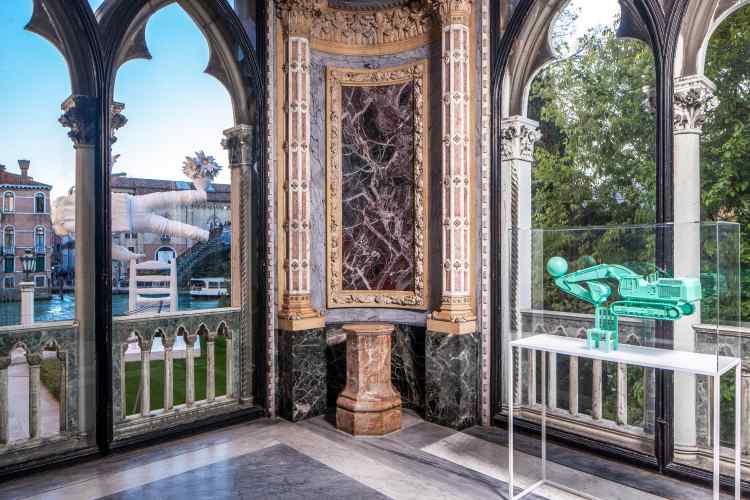Exhibition at Palazzo Franchetti
Beautiful Tomorrow is the title of the first solo show in Italy by Joseph Klibansky. The exhibition, hosted in Palazzo Franchetti, the prestigious headquarters of the Istituto Veneto di Scienze, Lettere ed Arti, is curated by Luca Berta, Francesca Giubilei and Demetrio Paparoni. It opens to the public from March 24th to May 1st, displaying more than 30 works that narrate the spectacular creative path of one of the most intere- sting young artists from The Netherlands.
A 9-meter spaceman precariously balances on top of a giant chair along the Grand Canal. A frowning gorilla blows a toy trumpet in the ballroom of a luxurious noble palace. The rainforest grows between silk brocades to reveal a golden sculpture. The photo-paintings by Klibansky, in which familiar urban landscapes overlap with remote wild environments, will be displayed along with his irreverent and poetic sculptures in resin, bronze, gold leaf. The exhibition catalogue will be published by Skira.
“Klibansky”, as claimed by curators Luca Berta and Francesca Giubilei, “metabolises the stereotyped reality spread by the new media, and gives us back a life beyond the surface, projecting symbols of contemporary multicultu- ralism and consumerism in the expanded and surprisingly innocent dimensions of his works”.
The use of new technologies is a distinctive trait of his artistic production. The bi-dimensional works origina- te from the superimposition of hundreds of photographs, on which the artist repeatedly intervenes with acrylic paint retouches on cotton paper, then applying liquid resin for a glossed finish.
The sculptures, mainly cast bronze or resin, involve 3D scanning and printing in the production process. A human touch remains integral to the work in that the final coating or polishing is always operated by the artist, thus reinforcing his interest in the interaction between old and new, cutting-edge technology and craftsmanship.
As stated by curator Demetrio Paparoni, “The works by Joseph Klibansky investigate the relationship betwe- en the object and its essence, between what we see and what lies beneath the image. The sense of precarious balance of his recent paintings and sculptures reveals how sadly dystopian an image can be, which looked happily utopian at a first glance. He shows how utopia and dystopia can live in the same image. [...] The whole work of Klibansky evokes contradictory messages, in order to set contradiction as one of the founding elements of his phenomenological re- search. What interests him is the relationship between appearance and what appears, and the way in which such a correlation enables a better understanding of the relationship between the self and the world”.
March 24 through May 1, 2016, Palazzo Franchetti, Venice, Italy
Joseph Klibansky
Joseph Klibansky was born in South Africa in 1984. He currently lives and works in The Netherlands. Recur- rent topics in his works are everyday life in contemporary large cities, recursive overlapping of real and digital, and the conflict between the past and the future. Conceptually close to the New Media Art, he uses innovative techniques that combine digitally altered photographs and pictorial interventions. He also creates sculptures in resin and bronze, often large sized. In spite of his young age, he has gained an outstanding reputation in the art system with displays at major international art fairs, impressive auction sales, and commissions from important corporate collections.
Klibansky was recently named # 1 art star by artprice.com in the top five youngest art stars under 30 (Art Price is the world leader in art market information).
His works have been exhibited in personal and group shows at galleries in Paris, Amsterdam, New York, Geneva, Saint Paul de Vence, Brussels, Honfleur, Moscow, Cannes, Marseille, Crans Montana, Mumbai, Saint Tropez, Chicago, Miami, and Antwerp. Recent art fairs include 2016 Tefaf, 2015 Art Miami, 2014 Scope New York, Scope Basel and Scope Miami/Basel. The Danubiana Museum in Bratislava and the Photographic Museum of the Mauritius Islands have purchased his works and show them in their permanent collections. In 2015 he was invited to be part of TRIO Bienal, the sculpture biennial in Rio de Janeiro. In 2017 the Museum de Fundatie in Zwolle (Netherlands) will host a solo show of Klibansky across two entire floors.
Palazzo Cavalli-Franchetti
Palazzo Cavalli-Franchetti is a palace in Venice, Italy, not far from the Ponte dell'Accademia and next to the Palazzo Barbaro on the Grand Canal of Venice. Since 1999 it has been the seat of the Istituto Veneto di Scienze, Lettere ed Arti and frequently houses cultural events.
The palace was erected in 1565. In the 19th century it was internally modernised and externally enriched in Venetian Gothic style, with rich window framing, by a series of grand owners. The first neo-Gothic improvements were made after 1840, when the young Archduke Frederick Ferdinand of Austria (1821–1847) reassembled the property, the Palazzo Cavalli-Gussoni,[1] which had become divided among heirs, and embarked on a complex project intended to give a more prominent Habsburg presence along the Grand Canal, as Austria-Hungary had been awarded the territories of Venice after the Napoleonic Wars. At his premature death, unmarried, in 1847 the palazzo was bought by Henri, comte de Chambord, styled "Henri V" by Bourbon legitimists,[2] who entrusted further restorations to Giambattista Meduna; his portrait on the balcony, with Santa Maria Della Salute in the background, is in the Palazzo Ducale, Modena.[3]
In 1878 Baron Raimondo Franchetti (1829–1905),[4] who had married Sarah Luisa de Rothschild (1834–1924), daughter of Anselm Salomon Rothschild of the Vienna Rothschilds, bought the palazzo and commissioned further works by architect Camillo Boito, who constructed the grand staircase. In September 1922 it was sold to the Istituto Federale di Credito per il Risorgimento delle Venezie by Franchetti's widow.


